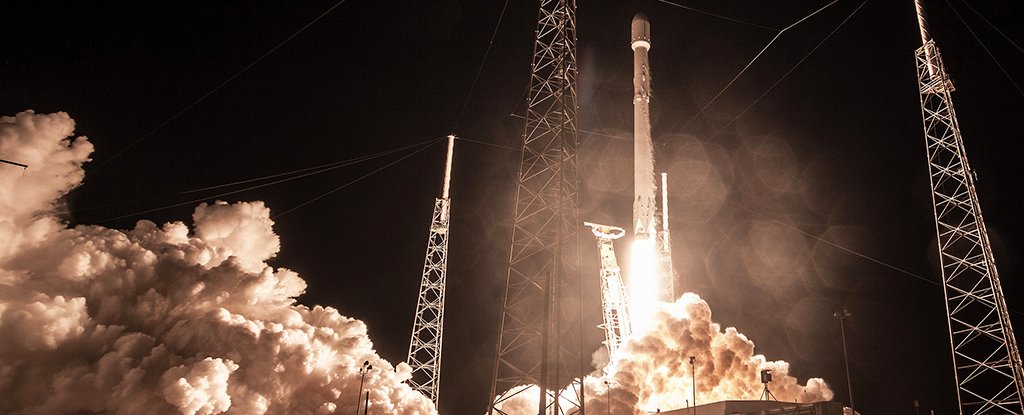Pentagon vraagt zich af waar supergeheime satelliet is gebleven
Deze foto is niet meer beschikbaarDe lancering van de Falcon-raket, met de Zuma-satelliet aan boord
© AFP
Een geheime Amerikaanse spionagesatelliet die zondag werd gelanceerd, is nooit in een baan om de aarde terechtgekomen. Dat heeft het Amerikaanse ministerie van Defensie laten weten.
Het ministerie weet niet waar het apparaat wel is, maar aangenomen wordt dat de poging is mislukt. Een Falcon-draagraket van de Amerikaanse raketbouwer SpaceX moest de satelliet in een baan om de aarde brengen. De lancering vanaf Cape Canaveral was om technische redenen al eerder uitgesteld.
Codenaam Zuma
Northrop Grumman is de bouwer van de miljarden kostende satelliet, die de codenaam Zuma droeg. Waarvoor de kunstmaan precies was bedoeld, is geheim.
SpaceX wil niet ingaan op de missie, maar laat wel weten dat de Falcon 9 normaal gefunctioneerd heeft. Dat zou uit de eerste data blijken.RTL Nieuws / ANP
Bron: https://www.rtlnieuws.nl
A SpaceX Falcon 9 rocket launched a secret payload for Northrop Grumman on Jan 7, 2017 from Space Launch Complex 40 at Cape Canaveral Air Force Base in Florida
Did Space X Just Lose a Super Secret Government Satellite? We May Never Know

SpaceX/Flickr
Conflicting reports are surfacing after SpaceX's seemingly successful launch of a Falcon 9 rocket with a secret government payload, code-named Zuma.
While it appeared that the launch went off without a hitch, the full launch and separation of the nose cone, which surrounded the secret satellite, was not streamed as it normally is, due to the classified nature of the mission.
Reports coming from the Wall Street Journal and Bloomberg are claiming that Zuma burned up upon reentry into the Earth's atmosphere.
These reports are partially based upon a briefing supposedly given to lawmakers and congressional staffers indicating that the satellite did not separate from the rocket as planned.
SpaceX did not report any problems with the launch; however, while the company usually announces a successful launch regardless of the classification of the payload, no confirmation was given by SpaceX or Northrup Grumman, the company that manufactured the secret satellite.
Futurism reached out to SpaceX and obtained the following statement from Gwynne Shotwell, President and COO of SpaceX:
"For clarity: after review of all data to date, Falcon 9 did everything correctly on Sunday night. If we or others find otherwise based on further review, we will report it immediately.
Information published that is contrary to this statement is categorically false. Due to the classified nature of the payload, no further comment is possible."
Sticking the landing
To confuse matters further, the Falcon 9's first stage was able to successfully landback on Earth, indicating that the rocket was still fully operational.
Even more so, the US Strategic Command added an entry to its Space-Track catalogue of artificial objects orbiting the planet, indicating that the new satellite was able to make at least one orbit.
That was before another confusing piece was added: their spokesman Navy Captain Brook DeWalt stated that Strategic Command had "nothing to add to the satellite catalog at this time."
This could either indicate that there is nothing to add in addition to the new satellite entry, or that the Zuma satellite is no longer in orbit.
The conflicting reports, coupled with the seemingly incongruous aftermath, are adding a rocket-load of mystery to an already mysterious launch.
Yet SpaceX seems confident that it played its part in the Zuma mission well, and the company does not foresee this mission disrupting its schedule.
According to Shotwell, "Since the data reviewed so far indicates that no design, operational or other changes are needed, we do not anticipate any impact on the upcoming launch schedule."
She continued: "Falcon Heavy has been rolled out to launchpad LC-39A for a static fire later this week, to be followed shortly thereafter by its maiden flight. We are also preparing for an F9 launch for SES and the Luxembourg Government from SLC-40 in three weeks."
Bron: http://www.sciencealert.com/
'Hallo NASA? Ik heb jullie satelliet teruggevonden'
Een Amerikaanse amateurastronoom heeft per toeval een satelliet teruggevonden die al sinds 2005 wordt vermist. De Amerikaanse ruimtevaartorganisatie NASA probeert nu het contact met satelliet IMAGE te herstellen.Scott Tilley was eigenlijk op zoek naar sporen van de spionagesatelliet Zuma, die na een mislukte lancering op 8 januari in rook leek te zijn opgegaan. Tijdens zijn zoektocht door de ruimte ving Tilley zendsignalen op van een ander, onbekend ruimtevaartuig met de code 2000-017A, 26113.
Tilley voerde de code in zijn database van gelanceerde ruimtevaartuigen in en ontdekte dat het satelliet IMAGE was. Hij beschreef zijn bevindingen in een blog.
Vernietigende zonnestralen
De Imager for Magnetopause-to-Aurora Global Exploration (IMAGE) werd gelanceerd in 2000 om de magnetosfeer van de aarde te bestuderen. De magnetosfeer is de ring die onze planeet onder meer beschermt tegen de vernietigende zonnestralen.
Eind 2005 ging het contact met de satelliet verloren, toen IMAGE bezig was de invloed van magnetische stormen op de atmosfeer van de aarde in kaart te brengen. NASA weet het verlies van de satelliet destijds aan een fout in de krachtbron.
De ruimtevaartorganisatie is nu in de archieven aan het zoeken naar oude software om het contact met IMAGE te herstellen. De hoop is zelfs dat de satelliet op termijn weer onderzoek kan gaan doen.
Bron: https://nos.nl/

 Pentagon is geheime satelliet Zuma kwijt
Pentagon is geheime satelliet Zuma kwijt





